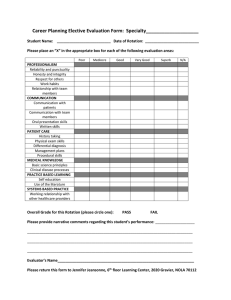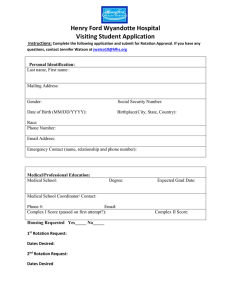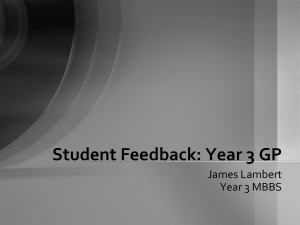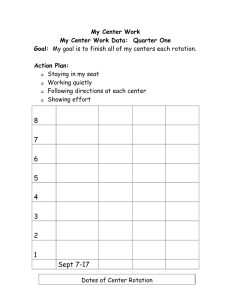Clinical Placement Logbook.Year 2015
advertisement
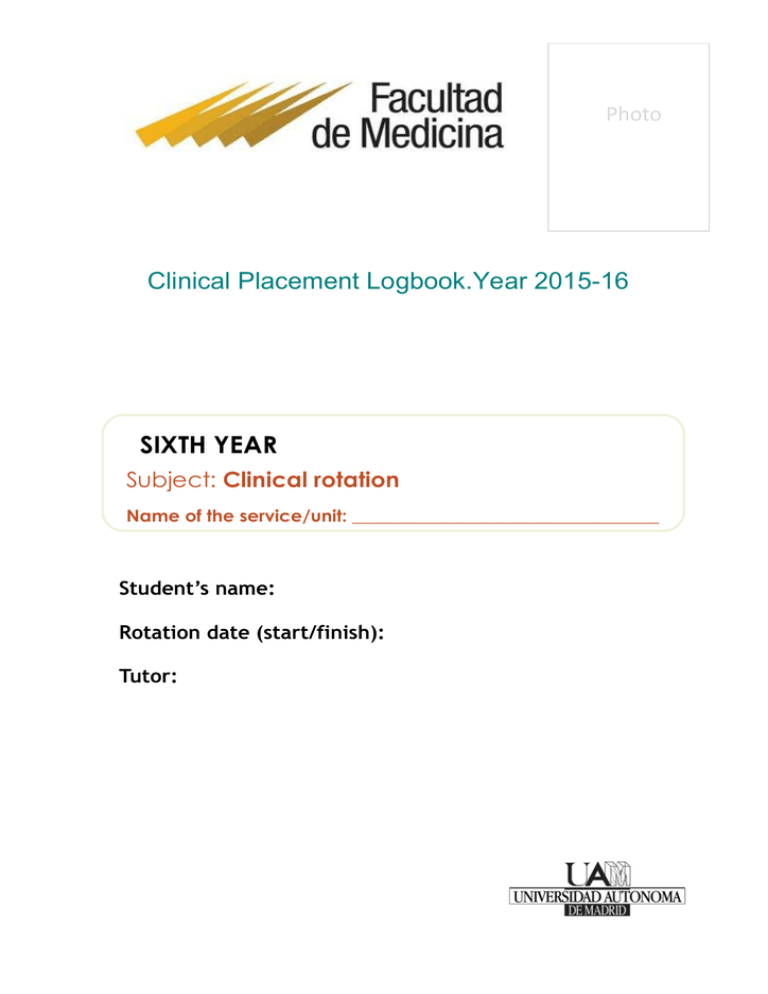
Photo Clinical Placement Logbook.Year 2015-16 SIXTH YEAR Subject: Clinical rotation Name of the service/unit: __________________________________ Student’s name: Rotation date (start/finish): Tutor: Clinical rotation placements allow students to consolidate their knowledge in a real clinical environment preparing them to face the most common problems in medical practice. Clinical rotations are performed during the normal hours of service (usually from 08:00to 15:00 hours), Monday to Friday, with students taking part in all and teaching activities at the centre, as a regular member of the service. Each student is assigned a tutor, who will be responsible for monitoring the student’s learning process and for assessing the rotation, and who will supervise the student’s performance of certain tasks that must be included in the clinical placement logbook. The Clinical Placement Logbook represents the main document on which students’ placement work will be graded. This document, drawn up by the students themselves, must be a reliable reflection of the students’ activities during a given rotation. It must be checked and signed by the students’ tutors. This activity record may include: Clinical histories. Assistance to the service’s activities. Attendance at specific activities (workshops, special techniques, etc.). Attendance at teaching activities within the Service. Any other documentation at testing the performance of activities during the student’s rotation in the service or unit. Student’s remarks. ClinicalPlacementLogbook AIMS OF THE ROTATION Listed below are the skills and abilities students are required to have acquired on finalising their rotation period: Professional values, attitudes and appropriate ethical behaviour. To draft clinical histories with all the pertinent information. To perform a physical examination and mental assessment. To draft a preliminary diagnostic judgement and establish a reasoned diagnostic strategy. To recognise and manage situations of imminent risk for life that require immediate action. To establish a prognosis and treatment for the most prevalent processes. To make adequate use of tests, medicaments and other health system resources. To listen attentively, obtain and synthesise information on the patient and draft clinical histories and other registers in an intelligible manner. To establish good interpersonal communication among patients, family members and other professionals. Knowledge and critical valuation of sources of clinical information. Appropriate handling of ICT. To preserve data confidentiality. To become actively integrated in the rotation. ClinicalPlacementLogbook ASSESSMENTOF THE CLINICAL ROTATION Clinical rotation grades will be given by the tutor following objective clinical evaluation procedures through: i. ii. The Clinical Placement Logbook. Performing a mini-CEX (mini Clinical Evaluation Exercise) after each rotation. The Mini-CEX serves to evaluate the following skills: • • • • • • Clinical interview skills Physical examination skills Professionalism Clinical judgement Communication skills Organization/efficiency Based on real patients’ clinical cases, this requires the presence of an observer to evaluate the aspects listed in the attached form. The aspects to be evaluated in each rotation are the following: Attendance and punctuality (maximum 1 point) Behaviour and interest shown (maximum 1 point) Clinical histories (maximum 2 points) Clinical management (drafting a preliminary diagnostic judgement, establishing a reasoned strategy, prognosis and treatment) (maximum3 points) Mini-CEX (maximum 3 points) ClinicalPlacementLogbook FORM FOR THE STRUCTURED OBSERVATION OF THE CLINICAL EVALUATION EXERCISE(MINI-CEX) Evaluator: Student: Clinical environment: out-patient ( ), emergency ( ), in-patient ( ), other ( ) Patient: Age………… Gender……….. Complexity of the case: low ( ), medium ( ), high ( ) Unsatisfactory (0-1) Satisfactory (2) Very Satisfactory (3) Anamnesis Physicalexamination Professionalism Clinicaljudgement Communicationskills Organization/efficiency Total sum x 0.3 ClinicalPlacementLogbook Not evaluable Observations After completing the mini-CEX, this document shall be discussed with the student as an excellent teaching and training tool. EVALUATION OF THE CLINICAL PLACEMENT LOGBOOK 1. Attendance and punctuality at the assigned service will be valued. 2. Connecting appropriately with the patient, family members and health personnel will be valued. 3. The number and quality of Clinical Histories drawn up by the student will be valued. 4. Clinical management: drafting a preliminary diagnostic judgement, establishing a reasoned diagnostic strategy, prognosis and treatment, capacity to synthesise and transmit information, and communication skills. 5. Skills test (Mini-CEX): This can be applied specifically, through the assessment of a member of faculty overseeing the student performing a clinical history or examining a patient, or as a consequence of repeated direct observation of the student during his or her clinical activities. CLINICAL PLACEMENT LOGBOOK ASSESSMENT FORM 1.Attendance and punctuality (maximum 1 point)……………………… 2. Behaviour and interest shown (maximum 1 point) ......................... 3. Clinical histories (maximum 2 points) .............................................. 4. Clinical management (maximum 3 points) ....................................... 5. Mini-CEX (maximum 3 points) .......................................................... FINAL GRADE for the CLINICAL PLACEMENT LOGBOOK (Points from 1+2+3+4+5) Signature of tutor responsible for the student *Submit to the Registrar at the Clinical Teaching Unit under sealed cover ClinicalPlacementLogbook STUDENT’S REMARKS ON THE ROTATION SERVICE/UNIT: TUTOR: Global assessment of the rotation: □ very good □ good □ room for improvement □ poor Positive aspects ________________________________________________________________ ________________________________________________________________ ________________________________________________________________ ________________________________________________________________ ________________________________________________________________ ________________________________________________________________ Negative aspects ________________________________________________________________ ________________________________________________________________ ________________________________________________________________ ________________________________________________________________ ________________________________________________________________ ________________________________________________________________ Other remarks ________________________________________________________________ ________________________________________________________________ ________________________________________________________________ ________________________________________________________________ ________________________________________________________________ ClinicalPlacementLogbook
